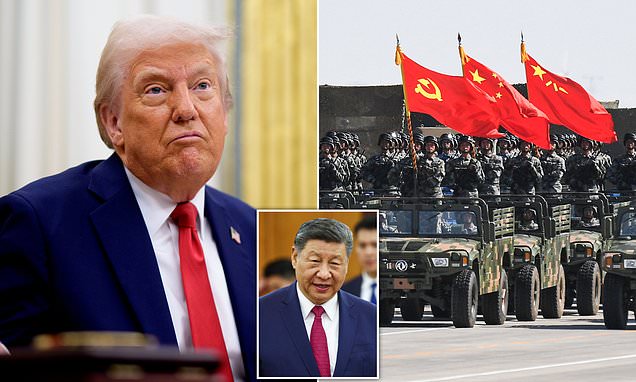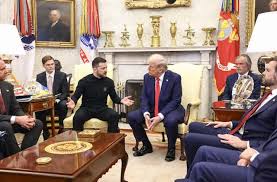President Donald Trump has issued an ominous new justification for his tariff hikes, saying more products need to be made in the United States so it is prepared in case of ‘war.’
On April 14, 2025, President Donald Trump intensified his economic offensive against China, signaling a bold escalation in the ongoing trade war between the United States and the world’s second-largest economy. Speaking to reporters aboard Air Force One, Trump justified his aggressive tariff hikes, leaving open the possibility of further levies while expressing a degree of flexibility regarding tariffs on critical consumer goods such as iPhones and tablets. The announcement, reported by the Daily Mail, has sent shockwaves through global markets, corporate boardrooms, and political circles, reigniting fears of a deepening economic conflict with far-reaching consequences. This article provides an in-depth exploration of Trump’s trade policies, the specific exemptions for electronics, the global economic fallout, China’s retaliatory measures, and the broader implications for consumers, businesses, and international relations.
The Context of the U.S.-China Trade War
The U.S.-China trade war, which began during Trump’s first term in 2018, has been a defining feature of his economic policy. Rooted in concerns over trade imbalances, intellectual property theft, and national security, Trump’s approach has consistently emphasized protectionism to bolster American manufacturing and reduce reliance on foreign imports, particularly from China. By 2025, the trade war had reached a fever pitch, with both nations imposing increasingly punitive tariffs on each other’s goods. The U.S. trade deficit with China, which stood at nearly $300 billion in 2024, has been a focal point of Trump’s rhetoric, with the president accusing Beijing of exploiting American consumers and businesses.
Trump’s latest tariff hikes, announced as part of his “Liberation Day” initiative, have pushed the total tariffs on Chinese imports to a staggering 145% in some cases, including a 125% levy imposed in early April 2025 and an additional 20% from earlier measures. China, under President Xi Jinping, has responded with reciprocal tariffs, matching the U.S. with a 125% levy on American goods, alongside nontariff barriers targeting key U.S. exports such as agriculture and energy. This tit-for-tat escalation has heightened fears of a global recession, with analysts warning that the trade war could disrupt supply chains, increase consumer prices, and destabilize financial markets.
Trump’s Tariff Strategy and Flexibility on Electronics
Central to Trump’s trade strategy is the imposition of tariffs to incentivize domestic manufacturing and reduce the U.S. trade deficit. On April 12, 2025, a surprising development emerged when the U.S. Customs and Border Protection quietly issued a notice exempting key electronics, including smartphones, laptops, hard drives, memory chips, and processors, from the 125% tariff on Chinese goods and the broader 10% global tariff. This move, which spared tech giants like Apple and Samsung from immediate financial strain, was seen as a significant retreat from Trump’s earlier hardline stance, which had included threats to impose tariffs on semiconductors and other critical technologies.
Speaking to reporters on Air Force One on April 13, 2025, Trump emphasized a pragmatic approach, stating, “The tariffs will be in place in the not-too-distant future, but we’ll also talk to companies. You know, you have to show a certain flexibility. Nobody should be so rigid.” This flexibility was further clarified by Commerce Secretary Howard Lutnick, who noted that the exemptions were not permanent and that electronics would be included in forthcoming semiconductor tariffs within the next month or two. The decision to exempt iPhones and other electronics was likely influenced by intense lobbying from tech companies and concerns about the immediate impact on American consumers, who rely heavily on Chinese-manufactured devices.
The exemption of electronics, particularly iPhones, was a significant win for companies like Apple, which manufactures over 80% of its iPhones in China. Analysts estimate that a 125% tariff on Chinese-made iPhones could have pushed the retail price of a 256GB iPhone 16 Pro from $1,100 to as high as $3,500, a cost that would likely have been passed on to consumers. By granting a reprieve, Trump avoided a potential “sticker shock” scenario that could have eroded public support for his trade policies. However, the temporary nature of the exemptions and the looming threat of semiconductor tariffs suggest that the reprieve may be short-lived, with companies like Apple, TSMC, and Nvidia facing pressure to accelerate efforts to diversify their supply chains.
China’s Response and Retaliatory Measures
China has not taken Trump’s tariff hikes lightly. On April 4, 2025, Beijing announced a 34% additional tariff on all U.S. imports, effective April 10, in retaliation for Trump’s 34% levy on Chinese goods. This brought the total tariffs on U.S. exports to China to 54%, when combined with earlier measures. The Chinese Finance Ministry described the move as a direct response to “unilateral bullying” by the U.S., with the Commerce Ministry filing a lawsuit with the World Trade Organization (WTO) to challenge the American tariffs. Additionally, China imposed export controls on seven rare earth elements critical to U.S. industries, citing national security and non-proliferation obligations.
Beyond tariffs, China has employed nontariff barriers to target Trump’s political base, particularly in red states. Over the past four months, Beijing has halted or curtailed U.S. agricultural and energy exports, including beef, poultry, and liquefied natural gas, which are predominantly produced in states supportive of Trump. These measures, described as “stealthy” by analysts, aim to inflict economic pain on Trump’s supporters, potentially undermining his domestic political standing. For instance, the National Chicken Council reported that China’s claims of sanitary concerns over U.S. poultry exports were unfounded, with the cited antibiotic having been banned in U.S. production for decades.
Chinese media and social media platforms have also escalated the propaganda war, using AI-generated memes and videos to mock Trump’s tariffs and portray Americans as unprepared for the return of low-skilled manufacturing jobs. A viral video on Chinese TikTok depicted obese American factory workers struggling with outdated sewing machines, while memes ridiculing tariffs on penguins from the Heard and McDonald Islands gained traction. These efforts reflect China’s strategy to undermine Trump’s narrative of economic revitalization, framing the tariffs as detrimental to American consumers and global trade.
Economic and Market Implications
The escalating trade war has triggered significant volatility in global financial markets. On April 4, 2025, Wall Street opened sharply lower, with the FTSE 100 in London suffering its worst day in five years, down 4.86% at close. Asian markets, including Tokyo and Shanghai, also experienced declines, reflecting widespread investor concerns about a potential global recession. A survey conducted by Chief Executive in April 2025 revealed that 62% of over 300 American CEOs anticipated a recession or economic downturn within six months, up from 48% in March. Ray Dalio, founder of Bridgewater Associates, warned on NBC’s Meet the Press that the U.S. was “very close to a recession” and that mishandling the trade war could lead to “something worse.”
The tariffs are expected to have a profound impact on American consumers. A Yale Budget Lab analysis estimated that the current tariff regime, even with the 90-day pause on some levies announced on April 9, could cost U.S. households $4,400 annually. Clothing and textiles are projected to face 58% higher prices in the short term, with long-term increases of 26%. The Consumer Price Index reported a 0.1% price drop in March 2025, but analysts warn that the full impact of the tariffs will likely manifest in higher costs for everyday goods, including electronics, toys, and apparel.
For tech companies, the tariff exemptions provide temporary relief but do not eliminate the long-term challenge of relocating supply chains. Apple, for instance, has begun diversifying its production, with approximately 1.5 million iPhones shipped from India to the U.S. in April 2025 to preempt tariff impacts. However, Bank of America Securities analyst Wamsi Mohan estimated that producing the iPhone 16 Pro Max domestically could increase its price by 91%, from $1,199 to approximately $2,300. The complexity of Apple’s supply chain, which spans nearly 50 countries, underscores the monumental task of achieving domestic production without significant cost increases.
Global Reactions and Negotiations
The trade war’s ripple effects have extended beyond the U.S. and China, impacting global allies and trading partners. The United Kingdom, under Prime Minister Keir Starmer, has expressed disappointment over Trump’s tariffs, with the Chancellor warning of a “profound” economic impact. The UK’s FTSE 100 slid 1.9% on April 13, 2025, reflecting concerns about the broader implications of protectionism. Starmer has advocated for a “more balanced global economic and trading system,” rejecting Trump’s approach and signaling a push for closer ties with the European Union and countries like India.
The European Union, facing a potential 50% tariff from Trump, has drawn up contingency plans for retaliation, with cars, pharmaceuticals, and machinery among the top exports at risk. Japan’s Prime Minister Shigeru Ishiba urged Trump to reconsider his tariff scheme, highlighting Japan’s significant investments in the U.S. as a counterargument to protectionist policies. Meanwhile, Trump’s decision to pause reciprocal tariffs on countries like India and Vietnam for 90 days has opened the door for negotiations, with U.S. Treasury Secretary Scott Bessent reporting that over 70 countries have reached out to discuss trade deals.
On May 12, 2025, a breakthrough was announced when the U.S. and China agreed to slash reciprocal tariffs by 115% for 90 days, reducing U.S. tariffs on Chinese goods to 30% and Chinese tariffs on U.S. goods to 10%. This temporary de-escalation, negotiated in Geneva, led to a surge in global markets, with Hong Kong’s Hang Seng jumping over 3% and Wall Street poised for a 3% gain. However, the agreement’s limited duration and the lack of a permanent resolution underscore the fragility of the current truce.
Political and Geopolitical Dimensions
Trump’s tariff policies are not solely economic; they are deeply intertwined with political and geopolitical objectives. The president has used tariffs as a tool to pressure allies and adversaries alike, demanding concessions on issues ranging from trade deficits to immigration. For instance, Trump’s imposition of 25% tariffs on Canada and Mexico, announced on February 3, 2025, was linked to demands for stronger border security measures. Similarly, his 50% tariff threat against India in September 2025 was a response to Prime Minister Narendra Modi’s alignment with Russia and China at an anti-NATO summit.
China’s retaliatory measures, including restrictions on Hollywood film imports announced on April 11, 2025, reflect a broader strategy to counter Trump’s narrative. By targeting cultural exports, Beijing aims to limit American soft power while minimizing economic damage to its own film industry, which relies minimally on Hollywood revenues. Trump’s dismissive response to this move, laughing it off during a Cabinet meeting, suggests confidence in the U.S.’s economic leverage, but it also highlights the theatrical nature of the trade war’s public discourse.
The trade war has also intersected with other geopolitical flashpoints. Analysts suggest that Trump’s tariffs could be leveraged to pressure China into mediating an end to the Russia-Ukraine conflict, given Beijing’s influence over Moscow. However, China’s growing technological capabilities and diversified trade relationships, as noted by expert Scott Kennedy, indicate that Beijing is better prepared to withstand U.S. pressure than during Trump’s first term.
Implications for Consumers and Businesses
For American consumers, the trade war’s impact is already being felt. The Yale Budget Lab’s estimate of a $4,400 annual cost per household highlights the potential burden on low- and middle-income families. Everyday goods, from clothing to electronics, are expected to see significant price increases, with analysts warning that companies like Apple may pass on tariff costs to consumers globally to maintain profit margins. The decision to exempt iPhones and laptops temporarily mitigates immediate price hikes, but the uncertainty surrounding future tariffs keeps consumers and businesses on edge.
Businesses, particularly in the tech sector, face a complex landscape. Apple’s CEO, Tim Cook, has been a key player in navigating the trade war, leveraging his relationships with both Trump and Xi Jinping to secure exemptions and explore alternative supply chains. The company’s $500 billion investment in U.S. facilities over the next four years reflects a strategic shift, but the logistical and financial challenges of domestic production remain formidable. Other tech giants, such as Nvidia and TSMC, face similar pressures, with Taiwan’s 20% tariff on semiconductor exports adding to the complexity.
Conclusion
President Donald Trump’s escalation of the trade war with China, coupled with his temporary exemptions for electronics, represents a high-stakes gamble with profound implications for the global economy. The decision to spare iPhones and laptops from tariffs reflects a pragmatic acknowledgment of the immediate impact on consumers and businesses, but the looming threat of semiconductor tariffs and the temporary nature of the exemptions suggest that the trade war is far from resolved. China’s retaliatory measures, including tariffs and nontariff barriers, underscore the tit-for-tat nature of the conflict, while global markets remain volatile amid fears of a recession.
The broader geopolitical context, including Trump’s pressure on allies and adversaries, adds complexity to the trade war, with implications for everything from consumer prices to international alliances. As negotiations continue and the 90-day tariff pause unfolds, the world watches closely to see whether Trump’s strategy will achieve its goal of revitalizing American manufacturing or lead to unintended economic and political consequences. For now, the trade war remains a defining challenge of Trump’s second term, with the potential to reshape the global economic landscape for years to come.









